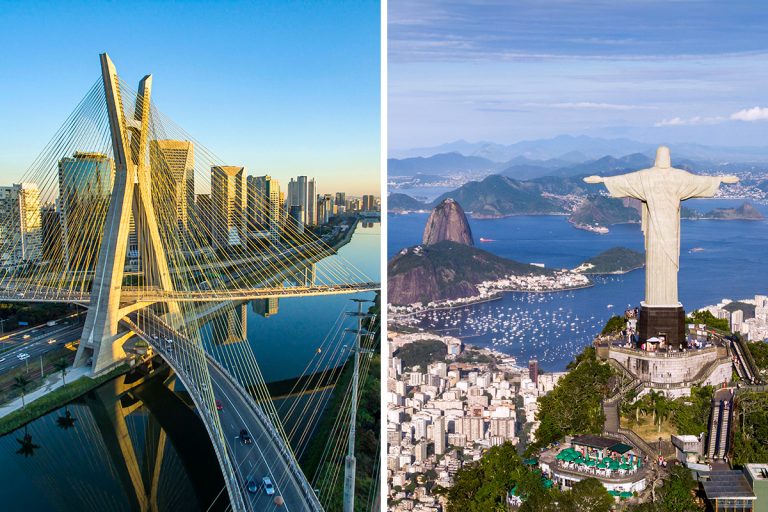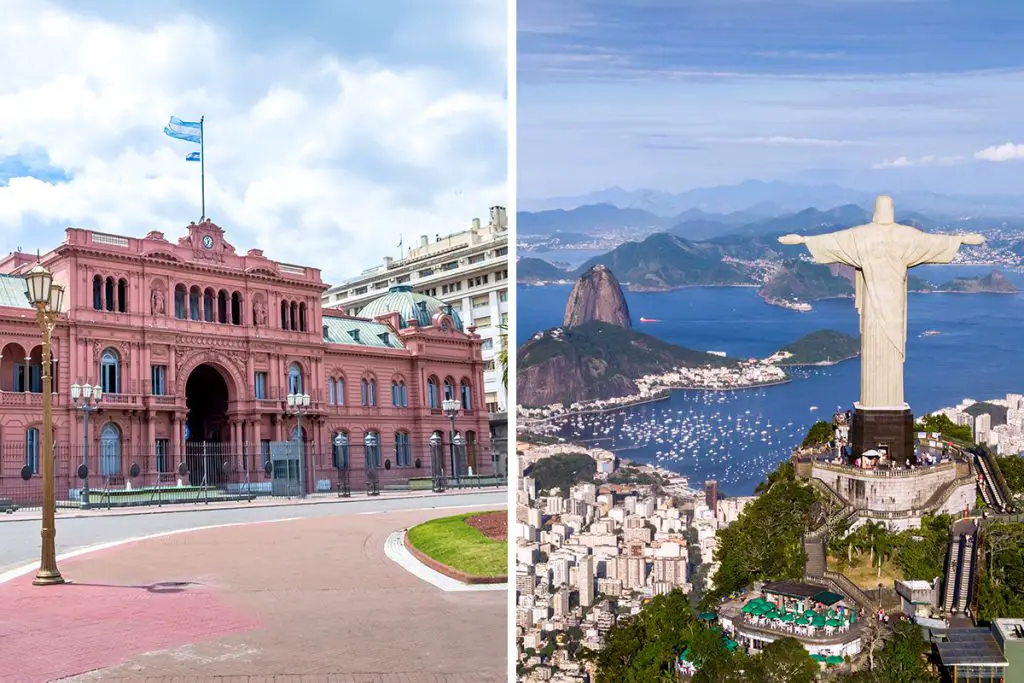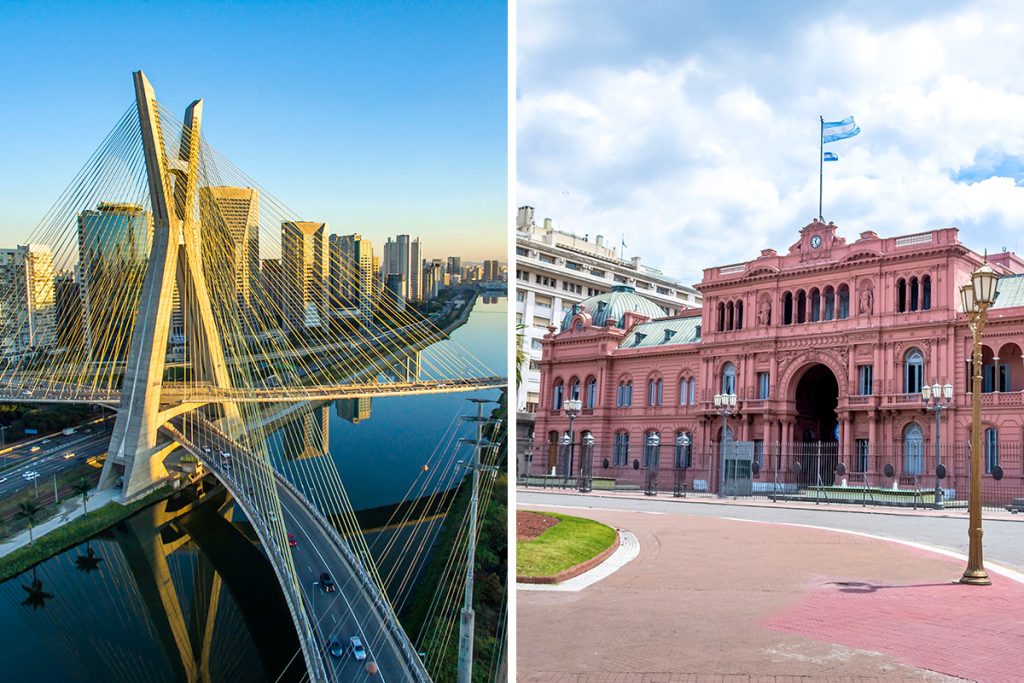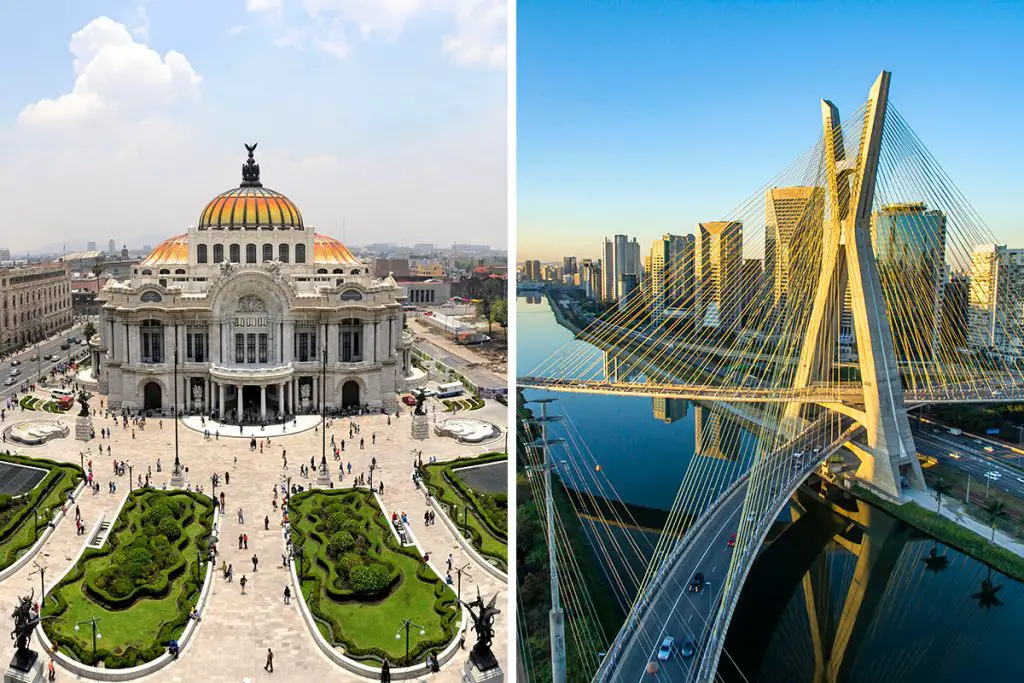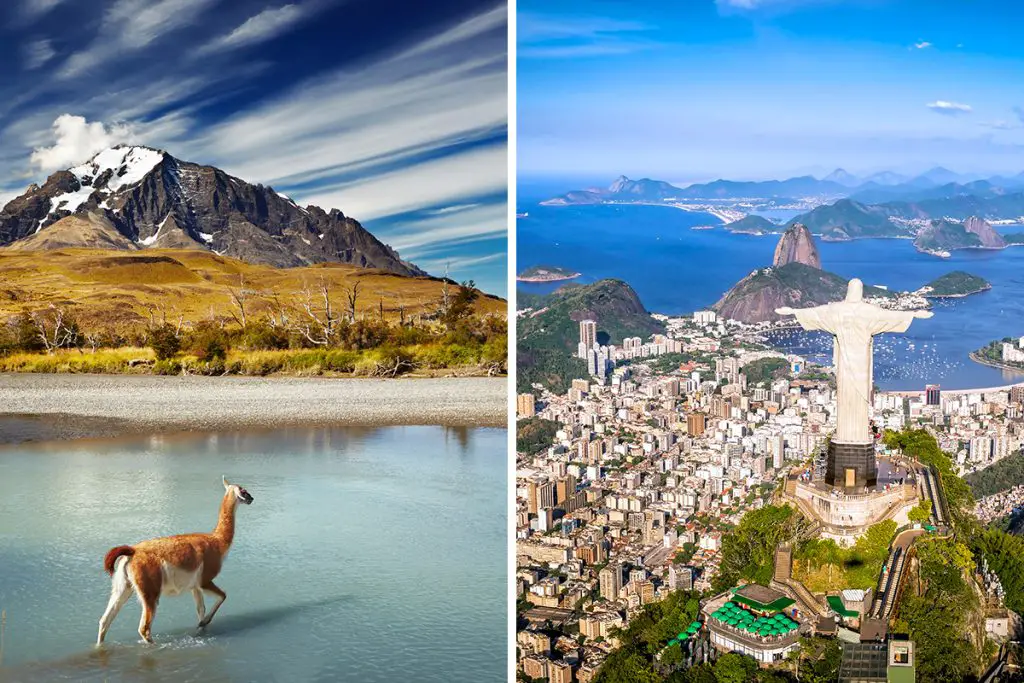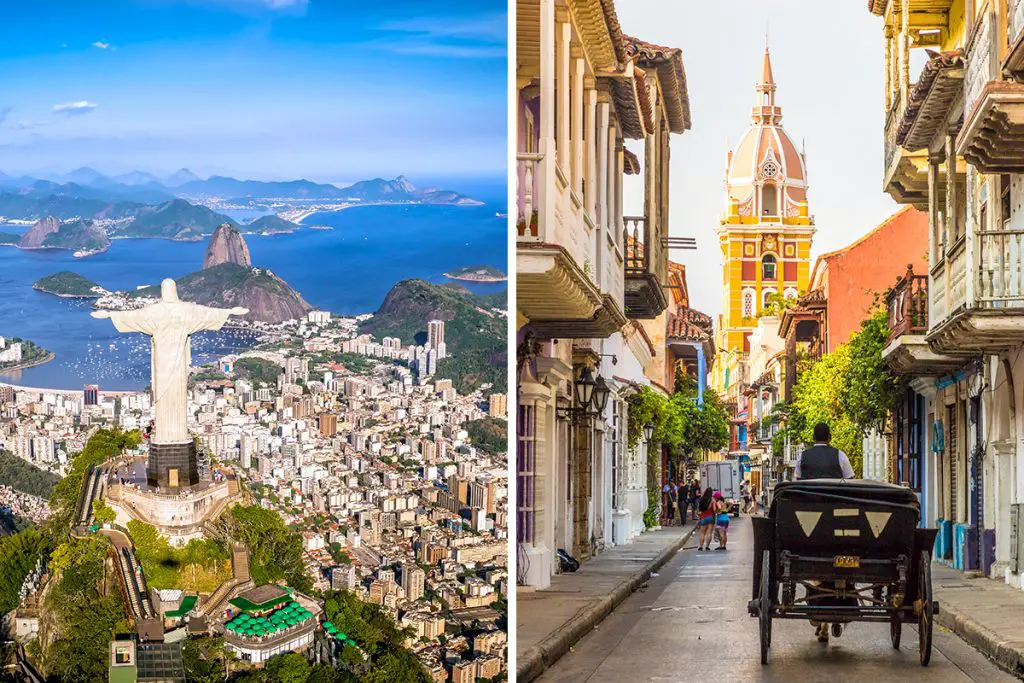Journeying through Brazil unveils the essence of a country with diverse cultural roots and a rich history. Your path might lead you to the heart of urban sophistication in Sao Paulo or along the rhythmic streets of Rio de Janeiro. The contrasting landscapes of these cities reflect the broad spectrum of Brazil’s historical narrative. A deeper dive into their individual histories and cultural fabric will surely enrich your Brazilian sojourn. Shall we delve into the heart of what makes each city a realm of unique experiences?
History & Culture
Embarking on a quest to unravel the historical and cultural ethos of Sao Paulo and Rio de Janeiro is akin to stepping into a vibrant tapestry of narratives.
Sao Paulo, often deemed the locomotive of Brazil, drives the country forward with its modern ethos. This bustling metropolis embraces the new, yet holds its historical roots close to its heart.
Its culture is a reflection of Brazil’s forward-looking spirit, imbued with a sense of tradition that narrates tales of the indigenous people, the Portuguese colonizers, and the waves of immigrants that have shaped its identity.
On the flip side, Rio de Janeiro is like a living museum, where every street corner has a story to tell. The city’s colonial past is more visible, echoed through its well-preserved architecture and the rhythm of samba that resonates through the air.
The cultural tapestry of Rio is a melodic blend of its indigenous roots, colonial past, and the influences of the African diaspora. It’s a city where the old and the new dance together in a celebration of what Brazil once was and what it has become.
The paths of Sao Paulo and Rio de Janeiro have intertwined and diverged through the annals of time, each city playing a significant role in Brazil’s narrative.
Sao Paulo’s rapid industrial growth in the 20th century marked a shift towards modernization, which is mirrored in its contemporary culture. The city’s ethos is a blend of tradition and modernity, manifesting in a cosmopolitan atmosphere that is both exciting and enriching.
Rio de Janeiro, on the other hand, has always been a city steeped in tradition. It was the capital of Brazil until 1960, a seat of power and culture that has left an indelible mark on its character.
The echoes of the past reverberate through the city’s lively festivities and the camaraderie among its people. The heritage of Rio de Janeiro is not just in its museums but in the everyday life of its denizens.
In summary, both Sao Paulo and Rio de Janeiro offer a rich but different tapestry of experiences when it comes to history and culture. Sao Paulo leans more towards a modern, progressive narrative while Rio de Janeiro holds closely to its traditional, historical roots. Each city presents a different facet of Brazil’s multi-layered narrative, waiting to be explored and cherished. Your journey through either city will not only educate but also enchant, opening up new avenues of understanding Brazil’s complex yet beautiful historical and cultural landscape.
Attractions & Activities
Embarking on the trails of attractions and activities in Sao Paulo and Rio de Janeiro unveils two distinct narratives of adventure and exploration. These cities, nestled in the heart of Brazil, offer a plethora of experiences that cater to the curious traveler.
In Sao Paulo, the skyline is your canvas, with towering structures narrating tales of modern architectural prowess. The São Paulo Museum of Art and the Museum of Contemporary Art are havens for art aficionados, housing a medley of international and Brazilian art.
For a touch of green amidst the urban sprawl, a stroll in the Ibirapuera Park offers a serene escape. The juxtaposition of modernity against a lush natural backdrop is a hallmark of Sao Paulo’s charm.
Rio de Janeiro, on the other hand, is a treasure trove of historical landmarks and natural splendors. The iconic Christ the Redeemer statue stands tall as a sentinel over the city, inviting explorers to delve into Rio’s scenic landscapes.
The Sugarloaf Mountain provides a vantage point that unveils the majestic cityscape, an experience that remains etched in the memory long after. The juxtaposition of natural beauty and historical allure beckons the curious heart to explore the myriad facets of Rio’s charm.
The spectrum of activities in Sao Paulo leans towards the artistic and the contemporary, offering a slice of modern-day Brazil. Its attractions provide a glimpse into the country’s progressive stride, embodying the dynamic spirit of Sao Paulo. The city’s essence is encapsulated in its modern edifices and lush parks, painting a picture of Brazil’s urban allure.
Conversely, Rio de Janeiro is a canvas of historical and natural beauty, each attraction a verse in Brazil’s melodious narrative. The city holds a promise of exploration that transcends the ordinary, touching the soul with its timeless beauty and historical charm. Rio’s allure lies in its ability to transport one through time, offering a glimpse into the heart of Brazil’s vibrant history.
In summary, Sao Paulo and Rio de Janeiro offer a myriad of attractions and activities that cater to a wide range of interests. While Sao Paulo embodies the urban and modern facet of Brazil, Rio de Janeiro resonates with the echoes of history and the allure of natural beauty. Your quest for adventure and exploration finds a distinctive flavor in each city, narrating a tale of Brazil’s diverse allure awaiting your discovery.
Beaches
Brazil’s coastline is a ribbon of golden opportunities for those seeking the serene embrace of the sea. Sao Paulo and Rio de Janeiro, two of Brazil’s iconic cities, offer distinct beach experiences that cater to varied tastes. While the beaches might not be the sole highlight, they embody the spirit of relaxation and recreation that is synonymous with Brazil’s coastal charm.
Sao Paulo’s coastline is less frequented yet holds a quaint charm. The beaches here, like the Praia de São Vicente, offer a tranquil escape from the city’s bustling pace. With a distance of around 65.2 kilometers (40.5 miles) from the heart of Sao Paulo, it’s a getaway that offers a serene respite.
Rio de Janeiro’s beaches are the epitome of Brazil’s vibrant beach culture. Copacabana and Ipanema are iconic names that resonate with the essence of sun, sand, and the rhythmic waves of the Atlantic. With a backdrop of towering peaks, the beaches in Rio are not just stretches of sand, but a celebration of life under the warm Brazilian sun.
The serene charm of Sao Paulo’s beaches offers a peaceful retreat, a place where the waves whisper tales of tranquility. The journey to these shores is a voyage into serenity, a respite from the urban hustle, offering a blend of calm and quietude.
On the other hand, the beaches in Rio de Janeiro are a lively tableau of Brazilian beach culture. The rhythm of life here is a melody that dances to the tune of the waves, offering a lively beach experience that is quintessentially Brazilian.
In summary, the beach experiences in Sao Paulo and Rio de Janeiro are as diverse as the cities themselves. Sao Paulo offers a tranquil retreat, a peaceful escape to the soothing embrace of the sea. Rio de Janeiro, with its lively beaches, embodies the vivacious spirit of Brazil, offering a vibrant beach experience that resonates with the heart of Brazilian culture. Your choice between the tranquil and the vibrant awaits as you set sail on your Brazilian adventure.
Eating, Drinking & Nightlife
The culinary realm of Sao Paulo and Rio de Janeiro is a journey of flavors waiting to tantalize the taste buds. These cities boast a rich gastronomic tradition that reflects the diverse cultural tapestry of Brazil.
Sao Paulo is a cosmopolitan hub, its food scene is as diverse as its populace. From gourmet dining experiences in upscale neighborhoods like Jardins to the traditional pastel de feira (street food pastry) in local markets, the city offers a broad spectrum of culinary delights.
Sao Paulo’s gastronomy is a delightful exploration that transcends borders, offering a taste of world cuisines while holding its Brazilian roots dear.
Now, shifting the gaze towards the drinking culture, Sao Paulo houses a myriad of bars and pubs that cater to every taste. The craft beer scene is burgeoning, with local breweries like Cervejaria Nacional leading the way. It’s a city where the art of mixology is celebrated, each cocktail narrating a tale of flavors.
Rio de Janeiro, on the other hand, is where traditional Brazilian fare takes center stage. The city’s love for feijoada, a hearty bean stew, and fresh seafood is apparent in the local eateries. The simplicity yet richness of flavors in Rio’s traditional dishes narrate tales of its cultural heritage.
As night descends, the lively nightlife of Rio de Janeiro beckons. The rhythm of samba reverberates through the night, as locals and tourists alike dance the night away in Lapa, the city’s nightlife hub. The essence of celebration is intertwined with Rio’s nocturnal culture, echoing the city’s love for music and dance.
In summary, the gastronomic and nocturnal adventures awaiting in Sao Paulo and Rio de Janeiro are distinct yet equally enchanting. Sao Paulo offers a cosmopolitan taste, a blend of modernity and tradition, while Rio de Janeiro embodies the heart of Brazilian culinary and nocturnal tradition. Your journey through the culinary streets and vibrant nights of these cities promises an unforgettable chapter in your Brazilian escapade.
Shopping
The retail landscapes of Sao Paulo and Rio de Janeiro are as diverse as the cities themselves. Each city offers a unique shopping experience that resonates with its cultural and urban ethos. The array of shopping venues ranges from modern malls to traditional markets, each telling a tale of the city’s commercial vibrancy.
Sao Paulo, being a modern urban hub, boasts a plethora of shopping malls like Shopping Iguatemi and Shopping Cidade Jardim. These malls house international and Brazilian brands, offering a cosmopolitan shopping experience. The city also hosts various street markets like Feira da Liberdade, which is a gateway to exploring local crafts and delicacies.
Rio de Janeiro, while not as cosmopolitan in its retail offerings, holds a charm in its traditional shopping venues. The Ipanema Hippie Fair and the Feira de São Cristóvão are realms where the local culture unfolds through crafts, apparel, and souvenirs. It’s a place where the spirit of Brazil is encapsulated in every item that catches your eye.
The juxtaposition between the modern retail landscape of Sao Paulo and the traditional market scene in Rio de Janeiro reflects the broader contrasts between these cities. Sao Paulo’s shopping scene is a blend of the modern and the luxurious, while Rio de Janeiro offers a taste of Brazil’s vibrant cultural heritage.
In summary, the shopping experiences in Sao Paulo and Rio de Janeiro offer a glimpse into the commercial and cultural ethos of these cities. Sao Paulo is your destination for a modern retail experience, while Rio de Janeiro provides a traditional shopping adventure. Your quest for unique souvenirs and the essence of Brazilian retail culture finds a distinctive narrative in each city.
Accommodation
The choice of accommodation is a pivotal part of any travel adventure. In Sao Paulo and Rio de Janeiro, the range of lodging options reflects the cities’ distinct characters. From modern hotels to quaint guesthouses, every traveler will find a place that resonates with their taste and preference.
In Sao Paulo, the landscape of accommodation veers towards modernity and urban sophistication.
The city hosts a myriad of contemporary hotels and serviced apartments, especially in upscale areas like Jardins and Vila Olimpia. These establishments often boast modern amenities, sleek designs, and a bustling ambiance reflective of Sao Paulo’s dynamic urban culture.
On the other hand, Rio de Janeiro offers a blend of modern hotels and charming guesthouses. In neighborhoods like Santa Teresa, you’ll find quaint pousadas (guesthouses) nestled amidst the lush greenery, offering a cozy and homely ambiance.
The city’s iconic Copacabana and Ipanema neighborhoods also host modern hotels that cater to travelers looking for a more standard lodging experience.
The choice between modernity and traditional charm extends to the service and hospitality you will encounter. Sao Paulo’s accommodation scene leans towards a professional, streamlined service. In contrast, Rio de Janeiro often offers a more personal touch, with the warmth of Brazilian hospitality shining through.
In summary, the accommodation in Sao Paulo and Rio de Janeiro caters to a variety of preferences. Sao Paulo offers a modern, urban lodging experience while Rio de Janeiro provides a blend of contemporary and traditional hospitality. Your choice will add a unique flavor to your Brazilian adventure, complementing the myriad experiences awaiting in these vibrant cities.
Family-Friendliness & Children’s Activities
Brazil is a country with a rich culture and a warm, welcoming atmosphere. Sao Paulo and Rio de Janeiro, as its prominent cities, offer a gamut of family-friendly activities that promise to enrich the travel experience for both adults and kids alike.
Sao Paulo, with its numerous museums like the Catavento Museum, which is dedicated to making science fun for kids, offers an educational yet enjoyable experience. The city also boasts green spaces like Ibirapuera Park where families can enjoy a leisurely day outdoors.
Rio de Janeiro, too, has its share of family-oriented attractions. The city’s rich natural landscape offers a playground for outdoor activities. Families can take a scenic tram ride to the top of Corcovado Mountain, a fun-filled adventure that also educates on the city’s natural and historical heritage.
On the artistic front, both cities hold a treasure trove of cultural experiences. Sao Paulo’s numerous theaters and Rio de Janeiro’s lively street festivals provide a cultural immersion that’s both entertaining and enlightening for young minds.
In terms of interactive learning, both cities have a rich offering. Sao Paulo’s kid-friendly museums and Rio’s natural wonders provide an engaging learning environment, making education an adventure in itself.
In summary, Sao Paulo and Rio de Janeiro offer an array of family-friendly activities that provide a blend of education, entertainment, and cultural enrichment. The choice between Sao Paulo’s urban offerings and Rio de Janeiro’s natural allure presents a delightful dilemma for families seeking a well-rounded travel experience.
Getting There & Getting Around
The journey to and the exploration of Sao Paulo and Rio de Janeiro are chapters filled with anticipation and excitement. The ease of access and navigation through these cities play a significant role in shaping the overall travel experience.
Getting to Sao Paulo is facilitated through its two major airports, Guarulhos International Airport and Congonhas Airport. They serve as gateways to the city from international and domestic destinations respectively.
Similarly, Rio de Janeiro is served by Galeão International Airport and Santos Dumont Airport, making the city easily accessible from various parts of the world and Brazil.
Once in Sao Paulo, the extensive metro and bus systems provide a convenient means to traverse the city. The 101.1-kilometer (62.8-mile) metro network ensures a relatively seamless movement across the urban expanse.
In Rio de Janeiro, the metro system, though not as extensive as Sao Paulo’s, coupled with a network of buses and trams, facilitates ease of movement. The 58-kilometer (36-mile) metro line connects key parts of the city, making exploration a breeze.
While both cities have their own set of challenges when it comes to traffic, the public transportation systems provide a viable option for navigating through the urban landscape.
In summary, getting to and moving around Sao Paulo and Rio de Janeiro is facilitated by well-established transportation networks. The choice between Sao Paulo’s extensive metro system and Rio de Janeiro’s blend of metro, buses, and trams offers a glimpse into the urban narrative of these Brazilian metropolises. Your journey through the transportation veins of these cities is sure to be an integral part of your Brazilian adventure.
Weather
The essence of travel is often intertwined with the weather, which plays a pivotal role in shaping the travel experience. Sao Paulo and Rio de Janeiro, being in close geographical proximity, share a tropical climate yet with distinct variations that cater to different preferences.
Sao Paulo experiences a subtropical climate with a fair share of rainfall spread throughout the year.
The summer, from December to March, sees temperatures ranging between 58°F to 86°F (14°C to 30°C), with January being the warmest month. The winters, spanning from June to August, are mild with temperatures hovering around 46°F to 75°F (8°C to 24°C), making it a pleasant time to explore the city.
Rio de Janeiro, on the other hand, boasts a tropical climate with warm temperatures year-round.
The summer months, from December to March, are hot and humid with temperatures often soaring to 95°F (35°C) or higher. The winter, from June to August, is mild and pleasant with temperatures ranging between 61°F to 77°F (16°C to 25°C), offering a respite from the summer heat.
The rainfall patterns also differ between the two cities. Sao Paulo receives a relatively even distribution of rainfall, while Rio de Janeiro experiences a drier period during the winter months.
The choice between the mild subtropical climate of Sao Paulo and the warm tropical climate of Rio de Janeiro boils down to personal preference.
In summary, Sao Paulo offers a cooler climate with mild summers and winters, while Rio de Janeiro provides a warmer, more tropical experience. Your choice will dictate the flavor of your Brazilian adventure, each city offering a unique weather narrative intertwined with its distinct charm.
Safety
Safety is a prime concern for any traveler. Sao Paulo and Rio de Janeiro, being large urban centers, have their share of safety issues, yet with appropriate precautions, they can be navigated safely.
Sao Paulo, with its bustling urban environment, requires travelers to exercise standard safety precautions against petty crimes like pickpocketing, especially in crowded areas and public transportation.
In Rio de Janeiro, similar precautions against petty crimes are advisable. The city’s touristic spots are well-patrolled, yet it’s always prudent to stay vigilant and avoid displaying valuables.
On a different note, both cities have made strides in improving infrastructure to ensure the safety and ease of movement for pedestrians and cyclists. Well-marked crosswalks, cycling lanes, and traffic signals contribute to a safer urban environment.
In summary, while both Sao Paulo and Rio de Janeiro have their set of challenges, with a mindful approach towards safety and adherence to local advisories, a secure and enjoyable travel experience is attainable. The cities continue to enhance urban safety measures, reflecting a commitment towards creating a hospitable environment for both locals and visitors.
Cost
The cost of traveling through Sao Paulo and Rio de Janeiro reflects the diverse economic landscape of Brazil. Each city presents a different spectrum of budgetary considerations that cater to a range of travel preferences.
In Sao Paulo, being a business hub, the cost of lodging, especially in upscale neighborhoods, can be higher. Dining can range from affordable street food to high-end restaurants. Transportation, with its extensive public network, offers a cost-effective way to navigate the city.
Rio de Janeiro, being a tourist magnet, has a wide range of accommodation and dining options catering to various budget levels. The city offers a blend of high-end establishments and budget-friendly alternatives, especially in areas like Copacabana and Lapa.
Transportation costs in both cities are relatively comparable, with a variety of public and private options available. Whether you choose to hop on a bus, take a metro ride, or hail a taxi, the cities offer flexible transportation solutions to suit different budget levels.
In conclusion, while the exact percentages may vary slightly from one source to another, all sources point towards Sao Paulo being the more expensive city in terms of cost compared to Rio de Janeiro. Hence, if cost-saving is a priority, Rio de Janeiro might be the more attractive option among the two. Nonetheless, the higher local purchasing power in Sao Paulo might offer better opportunities, making it a preferable choice for some individuals.
Which Is Better – Sao Paulo or Rio de Janeiro?
Embarking on a journey to the heart of Brazil unfolds a tale of two captivating cities – Sao Paulo and Rio de Janeiro. Each city, with its distinct personality, narrates a unique chapter of the Brazilian saga. Your choice between the urban sophistication of Sao Paulo and the natural allure of Rio de Janeiro will shape the narrative of your Brazilian adventure.
In the realm of History & Culture, Sao Paulo emerges as a modern metropolis, embracing the new while cherishing its historical roots. Its contemporary culture is a reflection of Brazil’s forward-looking spirit. Rio de Janeiro, with its well-preserved colonial architecture and rich historical narrative, offers a journey back in time, making it a living museum of Brazil’s vibrant past.
When it comes to Attractions & Activities, Sao Paulo’s urban landscape offers a blend of modernity and tradition, encapsulated in its modern edifices and lush parks. Conversely, Rio de Janeiro, with its natural beauty and historical landmarks, provides a canvas of exploration that transcends the ordinary.
The Beaches of Rio de Janeiro are a lively tableau of Brazilian beach culture, while Sao Paulo offers a tranquil retreat to the serene coastline, each catering to different tastes of beach experiences.
The scene of Eating, Drinking & Nightlife in Sao Paulo reflects its cosmopolitan nature, offering a taste of world cuisines in a modern, urban setting. Rio de Janeiro, on the other hand, embodies the heart of Brazilian culinary and nocturnal tradition, making each meal and night out a cultural experience.
The Shopping experiences in Sao Paulo and Rio de Janeiro offer a glimpse into the commercial and cultural ethos of these cities. Sao Paulo, with its modern retail landscape, caters to those seeking a cosmopolitan shopping experience. Rio de Janeiro, with its traditional markets, provides a taste of Brazil’s vibrant cultural heritage.
The choice of Accommodation in Sao Paulo leans towards modernity and urban sophistication, while Rio de Janeiro offers a blend of contemporary and traditional lodging options, catering to a wide range of preferences.
For families, the Family-Friendliness & Children’s Activities in both cities offer a rich blend of educational, cultural, and recreational experiences. Whether exploring Sao Paulo’s kid-friendly museums or Rio’s natural wonders, families will find engaging environments for children to learn and play.
Getting to and around Sao Paulo and Rio de Janeiro is facilitated by well-established transportation networks. Sao Paulo, with its extensive metro system, offers a seamless urban commute, while Rio de Janeiro, with a blend of metro, buses, and trams, provides ease of movement amidst its scenic landscape.
The Weather in Sao Paulo, with its mild subtropical climate, offers a cooler alternative to Rio de Janeiro’s warm tropical climate. The choice between the mild climate of Sao Paulo and the warm, beach-friendly climate of Rio de Janeiro caters to different weather preferences.
Safety in both cities requires a mindful approach and adherence to local advisories to ensure a secure and enjoyable travel experience. The cities continue to enhance urban safety measures to create a hospitable environment for both locals and visitors.
Lastly, the Cost of exploring Sao Paulo and Rio de Janeiro reflects the diverse economic landscape of Brazil. While Sao Paulo caters to a modern, upscale market, Rio de Janeiro offers a range of budget-friendly alternatives, making Brazil’s touristic allure accessible to a wide range of travelers.
In conclusion, the choice between Sao Paulo and Rio de Janeiro hinges on personal preferences. For those seeking a modern, urban experience with a hint of tradition, Sao Paulo is the city to explore. However, if the allure of natural beauty, historical landmarks, and a warm tropical climate resonates with your travel aspirations, then Rio de Janeiro is your destination. Each city, with its unique offerings, ensures that your Brazilian adventure will be a memorable chapter in your travel saga.

